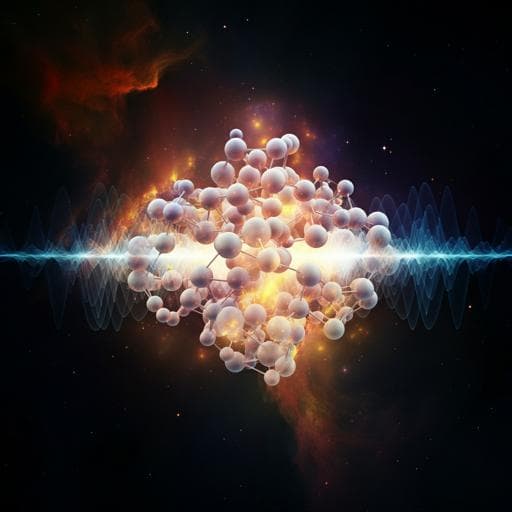
Physics
Reshaped three-body interactions and the observation of an Efimov state in the continuum
Y. Yudkin, R. Elbaz, et al.
Explore the fascinating world of Efimov states in ⁷Li atoms, where surprising metastable behavior challenges previous assumptions. This groundbreaking research, conducted by Yaakov Yudkin, Roy Elbaz, José P. D'Incao, Paul S. Julienne, and Lev Khaykovich, reveals crucial insights into three-body interactions and the effects of narrow Feshbach resonances.
~3 min • Beginner • English
Introduction
Ultracold atomic systems enable precise tuning of s-wave scattering length a via magnetic Feshbach resonances, allowing exploration of universal few-body physics such as the Efimov effect. For broad resonances (large s_res), Efimov physics exhibits van der Waals universality with a universal repulsive wall near hyperradius R ≈ 2 r_vdw, fixing the three-body parameter and the ground-state dissociation point. For narrow resonances (small s_res), an additional length scale r2 ≈ 1.912 r_vdw / s_res becomes relevant, altering three-body observables away from simple van der Waals universality. Precision studies for intermediate strengths have shown deviations, while some observations in 7Li appeared consistent with vdW universality, raising questions about universality limits. The present work investigates how narrow-resonance character reshapes three-body interactions and the Efimov spectrum near the atom-dimer threshold in 7Li (|F=1, mF=0⟩, 894 G, s_res ≈ 0.493), testing whether an Efimov state persists above threshold and clarifying its nature.
Literature Review
Prior work established vdW universality for broad resonances (e.g., 133Cs, 87Rb) with a universal repulsive wall around R ≈ 2 r_vdw and a universal a* where Efimov states intersect continua. Theoretical studies predicted modifications near narrow Feshbach resonances due to additional length scales (Petrov 2004; subsequent analytical and numerical works), and experiments at intermediate s_res (e.g., 39K) reported deviations from vdW universality. In 7Li, despite narrower resonances, some Efimov features appeared vdW-like, creating puzzles. Traditional few-body experiments rely on inelastic loss features and incoherent rf association to probe Efimov states. A previous proof-of-principle introduced a coherent interferometric approach (DITRIS) to resolve trimer-dimer energy differences with improved spectral resolution. Theoretical discussions have also considered possible bouncing of Efimov states at the atom-dimer threshold for broad resonances, but detailed multichannel calculations are needed for narrow-resonance systems like 7Li.
Methodology
Experiment: The authors implement a DITRIS (DImer-TRImer Superposition) interferometer using two short rf pulses to coherently create and probe a superposition of a weakly bound Feshbach dimer and an Efimov trimer on the a > 0 side of the 894 G 7Li Feshbach resonance (s_res ≈ 0.493) in the |F=1, mF=0⟩ state. A first rf pulse (10 µs FWHM with 4 µs turn-on/off; effective rectangular portion ~6 µs) is Fourier-broadened (FWHM ≈ 117 kHz) to simultaneously address both dimer and trimer states. After a variable free evolution time (up to ~100–150 µs, limited by coherence), a second identical pulse mixes the states. The number of free atoms is measured by absorption imaging; oscillations versus evolution time arise from interference between dimer and trimer pathways. The dominant oscillation frequency gives |E_T − E_D|/h. Detection window is bounded below by temperature (T ≈ 1.5 µK ≈ 30 kHz) and above by the pulse bandwidth (~117 kHz). The atomic sample consists of ~3 × 10^6 7Li atoms at 1.5 µK and average density 1.25 × 10^12 cm−3 in a crossed optical dipole trap. Magnetic-field stabilization achieves relative stability ~5 × 10^−5. Scattering length calibration is performed via precise dimer binding energy measurements linked to coupled-channel calculations, yielding <1 a0 uncertainty in the explored range. Data analysis uses a Fourier-transform-inspired three-parameter fit to extract the dominant oscillation frequency with improved accuracy for longer evolution times.
Theory: The adiabatic hyperspherical representation is used to compute three-body effective potentials and energies. A two-channel van der Waals model with tunable s_res (and 7Li-like a_bg ≈ −25 a0) elucidates how decreasing s_res reshapes the three-body effective potential W(R): for narrow resonances a repulsive barrier emerges for R ≳ 4 r_vdw extending to ~3 r* (r* ≈ 1.912 r_vdw/s_res), creating a double-well structure. Building on this picture, multichannel calculations with realistic 7Li two-body potentials (modified to account for strong short-range exchange) are performed to obtain trimer energies below threshold and to identify signatures above threshold via atom-dimer elastic scattering. Above threshold, the presence and energy of a metastable Efimov state are inferred from enhancement in the weighted atom-dimer elastic cross-section difference Δσ_AD^0(E) relative to a broad resonance case matched to the same low-energy a_AD, with short-range decay suppressed to focus on elastic features.
Key Findings
- Coherent spectroscopy reveals that as the scattering length decreases, the Efimov trimer energy exhibits an unexpected sharp turn near the atom-dimer threshold rather than smoothly merging, and the interferometric signal disappears below the lower detection limit (~30 kHz) before reappearing at smaller a with increasing frequency, indicating the trimer persists above threshold.
- Experimental frequency data show the threshold crossing occurs between a ≈ 177 a0 and 160 a0. Example time traces and fits confirm coherent oscillations both below (e.g., a = 265 a0) and above (e.g., a = 156 a0) the atom-dimer threshold.
- The DITRIS interferometer measures |E_T − E_D|/h in the ~30–117 kHz window set by temperature and pulse bandwidth; for large a, results agree with prior incoherent spectroscopy, while near threshold coherent data deviate from vdW expectations, consistent with a trimer surviving in the continuum.
- Numerical hyperspherical calculations with a two-channel model show that as s_res decreases into the narrow regime (s_res ≲ 1), the universal repulsive wall at R ≈ 2 r_vdw disappears and a new repulsive barrier arises for R ≳ 4 r_vdw up to ~3 r*, producing a double-well three-body potential. For 7Li-like parameters (s_res ≈ 0.41–0.493), the barrier height at a = ±∞ is ~10 MHz (~0.02 E_vdw), far larger than experimental binding energies, and it persists for finite positive a, allowing shape-resonance-like Efimov states above threshold.
- Multichannel 7Li calculations qualitatively reproduce a trimer crossing into the atom-dimer continuum and identify the above-threshold Efimov state via an enhancement in the weighted atom-dimer elastic cross-section difference Δσ_AD^0(E) relative to a matched broad-resonance system. The peak in Δσ_AD^0(E) tracks the Efimov state energy above threshold.
- Time-domain data indicate coherent oscillations without observable decay up to ~100 µs (empirically stable up to ~150 µs), substantially longer than naive trimer lifetime estimates (~10–20 µs), suggesting altered coherence dynamics in narrow-resonance three-body physics.
- Overall, both experiment and theory refute the conventional expectation that an Efimov state simply vanishes at the atom-dimer threshold for narrow Feshbach resonances.
Discussion
The central question is whether narrow Feshbach resonances fundamentally alter three-body interactions near the atom-dimer threshold. The observations show that in 7Li (s_res ≈ 0.493) an Efimov state persists as a metastable state embedded in the atom-dimer continuum, evidenced by coherent DITRIS oscillations above threshold and by theoretical elastic cross-section enhancements. The two-channel hyperspherical analysis attributes this to a repulsive barrier in the atom-dimer channel for R ≳ 4 r_vdw, which, together with an inner vdW-dominated well, creates a double-well effective potential. This structure supports a quasi-bound Efimov state (shape resonance) above threshold, explaining the non-monotonic energy behavior and reemergence of coherent signals as a decreases. The findings challenge vdW universality expectations derived from broad resonances and indicate that r* (or s_res) governs three-body properties for narrow resonances. The unexpectedly long coherence times suggest that the superposition state and the reshaped three-body potential may suppress decoherence or modify coupling to loss channels, motivating further study of coherence mechanisms in few-body systems under narrow resonance conditions.
Conclusion
The work demonstrates, via coherent DITRIS interferometry and supporting hyperspherical theory, that a 7Li Efimov trimer can exist as a metastable state above the atom-dimer threshold near a narrow Feshbach resonance. This provides direct evidence that narrow resonances reshape three-body interactions, introducing a repulsive barrier and a double-well potential that allows Efimov states to survive in the continuum. The results clarify the nature of 7Li Efimov states and highlight deviations from van der Waals universality for narrow resonances. Future research should quantify trimer lifetimes and coherence properties, refine multichannel interaction models for lithium to achieve quantitative agreement, and extend DITRIS-based coherent spectroscopy to other atomic species and mixtures to map universality across resonance strengths.
Limitations
- Theoretical models required approximations to manage complex multichannel lithium interactions; quantitative agreement with experiment is limited, especially for energies close to the Feshbach resonance on the bound side.
- Short-range decay mechanisms were suppressed in some calculations to emphasize elastic features, which may not capture all inelastic processes.
- Matching of atom-dimer scattering lengths between narrow and broad resonance cases was approximate (~2% differences), potentially affecting Δσ_AD^0(E) at higher energies.
- Experimental detection is bounded by temperature (~30 kHz lower limit) and pulse bandwidth (~117 kHz upper limit), restricting accessible energies and potentially missing features.
- The low signal-to-noise ratio prevents precise measurement of decoherence; trimer lifetime is not directly measured and remains uncertain.
Related Publications
Explore these studies to deepen your understanding of the subject.







